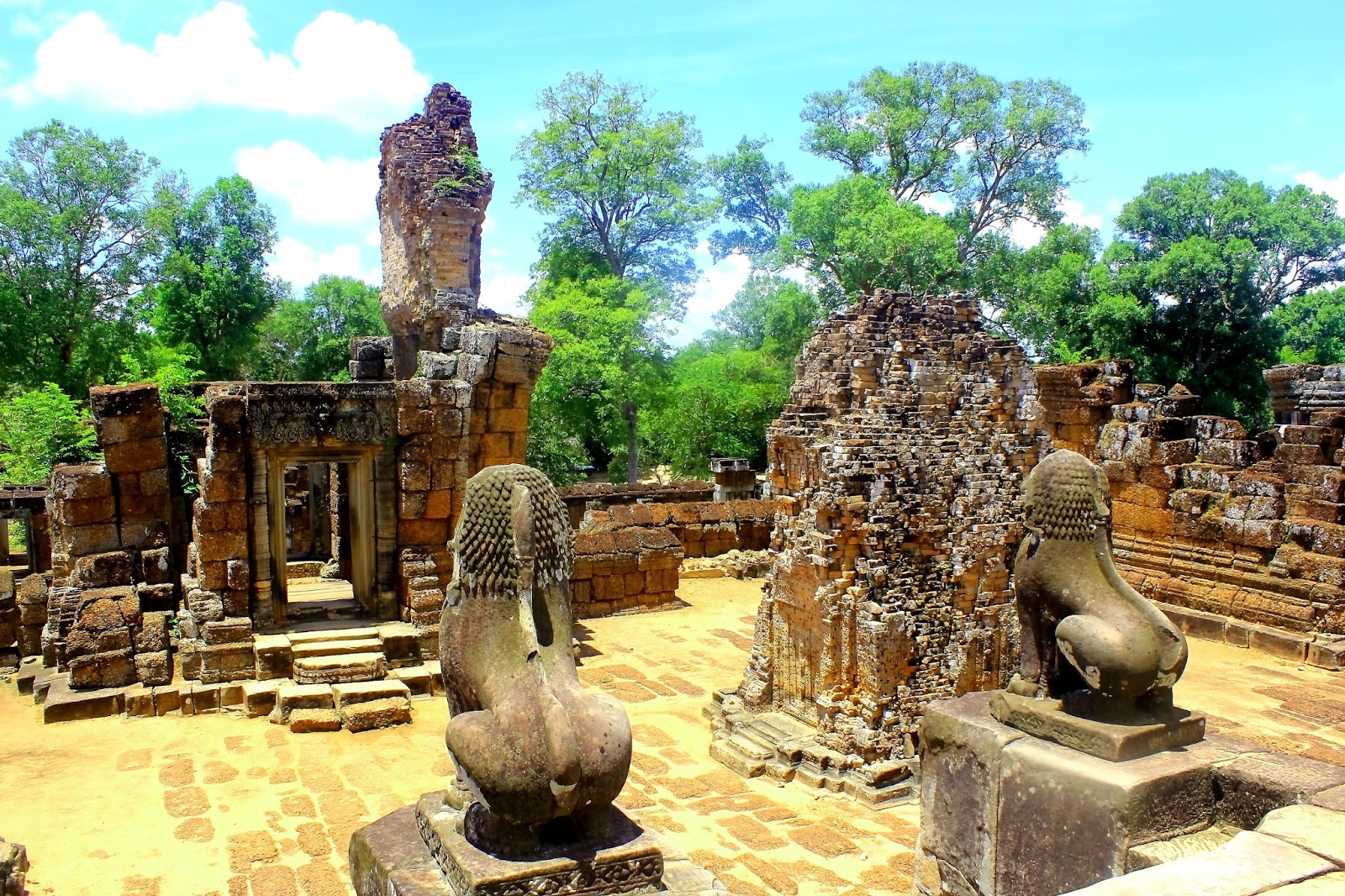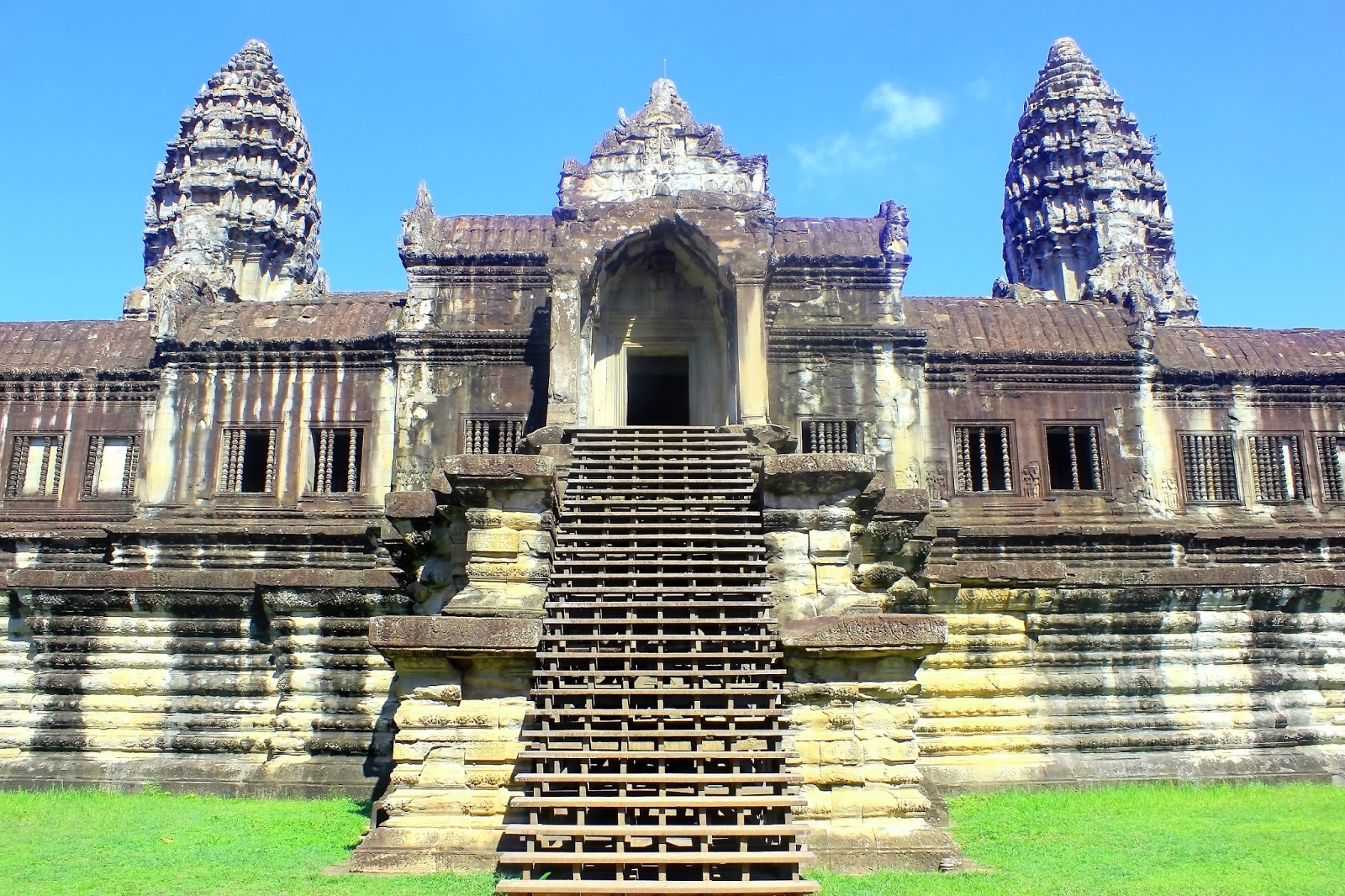 |
| Angkor Wat |
As the plane landed on the Siem Reap Internationl Airport, we could feel Angkor Wat's presence. I saw the Cambodian's flag. The world famous temple was embedded proudly within. The passengers in the plane were talking on Angkor Wat during the 2 hours flight from Singapore. We could understand why. There was only 1 theme within the airport. Everything was centered around Angkor Wat. As we explored the city later, it was unanimous. The hotels, souvenirs, shirts, beers, foods, advertisements were all linked in a way or another to the ancient temple. My cousin-Bayee, who was one of my traveling companions, asked an interesting question-what if Angkor Wat vanishes one day? Will Cambodia be able to survive without it's icon? Of course, no one has the perfect answer and it is really something to ponder upon.
 |
| Apsaras |
 |
| Terrace of The Leper King |
Our days in Cambodia would take us to mountain temples and ancient ruins. The reason why they are called mountain temples was simple. They were constructed to resemble mountains! In fact, the highest peak is the sacred Mount Meru which is considered to be the center of all the physical, metaphysical and spiritual universes by Buddhists and Hindus. It was no easy feat to "run" from temples to temples, trekking through the ruins and conquering the temples by clambering the steep stairs and reaching the highest points. The killer was always the unforgiving hot and humid weather. During our visit, it ranged from 32 to 37 degree Celsius! At the the end of each day, we would try to recover by having a sumptuous meal and a good Khmer massage. The three of us have developed "temple out" syndrome and lost count of the temples that we have visited when we left Siem Reap. But none of us has regretted the decision to visit the recognized UNESCO World Heritage Site.
 |
| Pre Rup |
 |
| East Mebon |
We decided to engage tour guide on our trip at Angkor as we want to understand the histories of the ruins. It was a great decision as they brought us around in air-conditioned van and made the temples came alive with their narratives. You can see my review of them at
TripAdvisor.
 |
| Benteay Srei |
 |
| Preah Khan |
Many people still have the wrong perception that Cambodia has only Angkor Wat. In fact, the well-preserved Angkor Wat was just one of the many temples built in the Angkor period.There were the "first generation temples" called the Roulous group which consists of Lolei, Preah Ko and Bakong. Though not as well-decorated as the latter temples, they were the oldest around. We also visited Bayon-The Temple of Many Buddhas faces, Ta Promh-The Jungle Temple, Benteay Srei-The Lady Temple, Pre Rup, The Royal Palace, Baphuon, Preah Khan, East Mebon, Terrace of the Leper King, Terrace of The Elephants and many others.
 |
| Preah Ko |
 |
| Horses grazing at The Terrace of The Elephants |
It was virtually impossible to talk about all the temples that I visited at Siem Reap. I could only pick my top three but this would surely not do justice to the rest of the magnificent architectures.
 |
| Statue at the side entrance of Angkor Wat |
Angkor Wat- Who dare says he/she visited Cambodia without visiting Angkor Wat? It is the largest religious monument in the world and even bigger in reputation than the country itself. As we walked through the large temple complex, we could imagine it's glory during it's heyday. Thousands of soldiers with their horses and elephants steads would march through the ground, led by their King as they headed to the main temple ground to pray to their deity Vishnu. Apsaras, the court female dancers which adjourned the walls of the temple, would dance to Khmer music performed by the King's specially selected musicians.The endless bas reliefs at the temple walls told the stories of their deities and God-kings. Great battles were fought which the righteous sides would eventually prevail. The one I found most interesting is the one on the Churning of the Milky Ocean. The gods (Devas) and demons (Asuras) stood in an orderly row at opposite end and pulled the Serpent King (Naga) at either end to churn the ocean of it's Amrita or the nectar of immortal life. You could see the story in statues form at the gate of Angkor Thom though most of the original statues' heads were sadly decapitated and stolen.
 |
| Outer Complex of Angkor Wat |
 |
|
| Bas Relief at Angkor Wat |
|
 |
| Gallery of Bas Reliefs |
 |
| Makeshift Stairs to inner keep of Angkor Wat |
The greatest accomplishment would be entering the inner keep of the temple and conquering "Mount Meru". We would need to climb a set of steep steps to reach the top end of the temple. This was the place where I finally came face to face to the five prominent "Gopuras" which formed the famous outlook of the Angkor Wat that one would normally see in TV, magazines or post cards.In the past, only the King himself and high-ranking priests could allow to step into this sacred ground. The feeling of finally realizing one of the items in my wish lists was indescribable.
 |
| Monks at Angkor Wat |
The Bayon-The moment I set my eyes on the temple, I immediately fell in love of this marvelous architecture. From a distance, you could see the many imposing Buddhas faces smiling and seeming to welcome us to it's holy ground.As we entered into the temple complex, I was captivated by more Buddhas' faces looking at us from different angles. According to our tour guide-Sothorn, this was the first and last mountain temple dedicated to Buddhism in Angkor. The rest of the mountain temples were actually built in the name of Hinduism. As an avid photographer, my camera never stop clicking in the temple compound. I realized I took more photos in Bayon than any other temples in Siem Reap. No wonder it is easily the most popular tourists' site after Angkor Wat. It's really hard to imagine how the people then could construct a temple with such complexity with bare hands and basic tools.
 |
| The Bayon 1 |
 |
| The Bayon 2 |
 |
| The Bayon 3 |
 |
| The Bayon 4 |
Ta Prohm-This temple was made famous by Angeline Jodie for the show-The Tomb Raiders. I realized even without her, Ta Prohm should already been popular due to it's unique presence. Ta Prohm was called "The Jungle Temple" for good reason. Ancient trees with their massive roots have integrated as part of the temple structures. Those who have good imagination would immerse themselves as actors or actresses in Indiana Jones or Lord of the Rings adventures, where the ancient trees would suddenly come alive and use their roots to entwine and engulf those that dare ventured this deep to threaten the temple's treasure. During our visit, the place was under extensive renovation. Sadly, many
of the trees have been removed (fully or partially) as their presence
was slowly destroying the temple structure.
 |
| Ta Prohm 1 |
 |
| Ta Prohm 2 |
 |
| Ta Prohm 3 |
 |
| Ta Prohm 4 |
Despite the flourish of tourism in Siem Reap, we could still see many poor people around. Small children, some younger than my 6 years old daughter, were trying to sell me souvenirs at almost all temples I visited. It was a sad sight to witness as they should be studying in school instead of plying their trades at the temples. We knew it was impossible to buy from everyone of them. Let's hope the situation will get brighter for them as things become better.
 |
| Children at the Ruins |
I posed an interesting question to my traveling buddies-Bayee and Tet at the end of our journey. Would they come back to Siem Reap and explore the temples again? Their answers were affirmative "NO". One time experience was good enough was their main reason. What about myself? I would not say no if I have the opportunity to come back again. That will be the time that I really want to blend into the culture and everyday lives of the Cambodians. Of course, I will not forget about the temples. I hope I still have the strength and desire to conquer the mountain temples by then :-).
Related Posts: Prelude-Visit to Angkor Wat, Siem Reap,
After Thought-Visit to Siem Reap, Cambodia
|
|
Group photo at Angkor Wat-Myself, Bayee and Tet |
 |
| For Your Pinning |

